Bochao Li
An Understanding-Oriented Robust Machine Reading Comprehension Model
Jul 01, 2022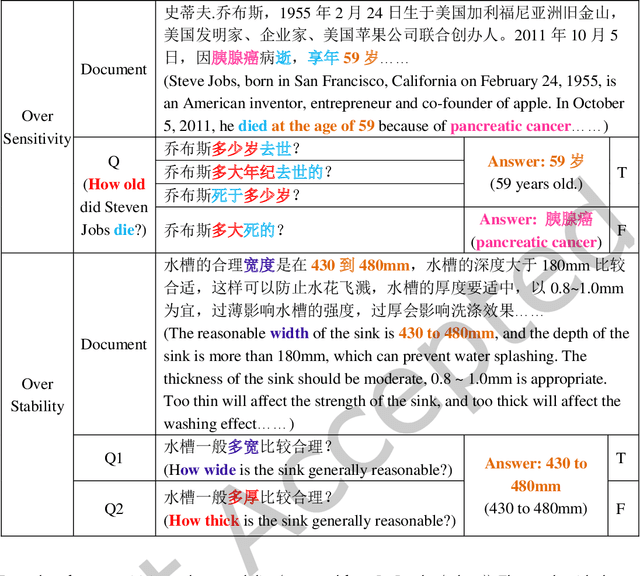
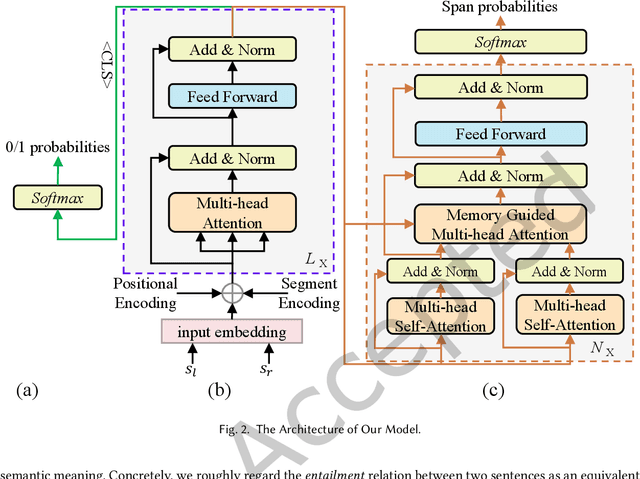
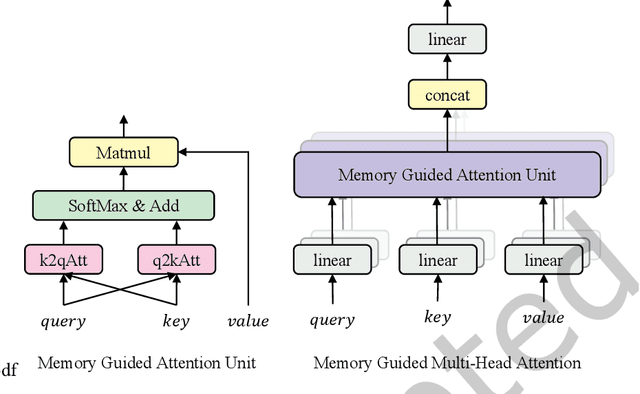

Abstract:Although existing machine reading comprehension models are making rapid progress on many datasets, they are far from robust. In this paper, we propose an understanding-oriented machine reading comprehension model to address three kinds of robustness issues, which are over sensitivity, over stability and generalization. Specifically, we first use a natural language inference module to help the model understand the accurate semantic meanings of input questions so as to address the issues of over sensitivity and over stability. Then in the machine reading comprehension module, we propose a memory-guided multi-head attention method that can further well understand the semantic meanings of input questions and passages. Third, we propose a multilanguage learning mechanism to address the issue of generalization. Finally, these modules are integrated with a multi-task learning based method. We evaluate our model on three benchmark datasets that are designed to measure models robustness, including DuReader (robust) and two SQuAD-related datasets. Extensive experiments show that our model can well address the mentioned three kinds of robustness issues. And it achieves much better results than the compared state-of-the-art models on all these datasets under different evaluation metrics, even under some extreme and unfair evaluations. The source code of our work is available at: https://github.com/neukg/RobustMRC.
Deep Understanding based Multi-Document Machine Reading Comprehension
Feb 25, 2022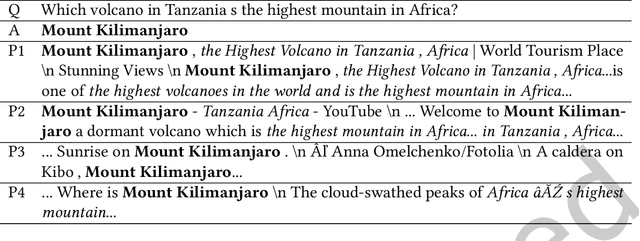
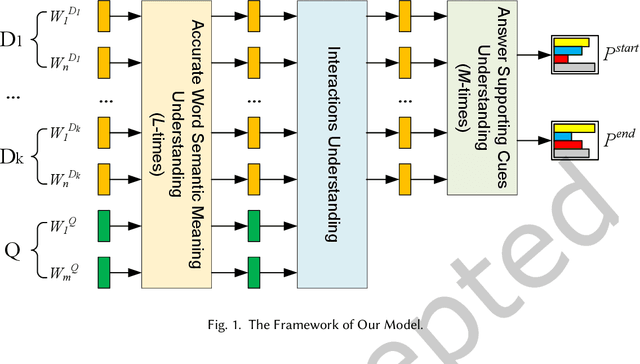

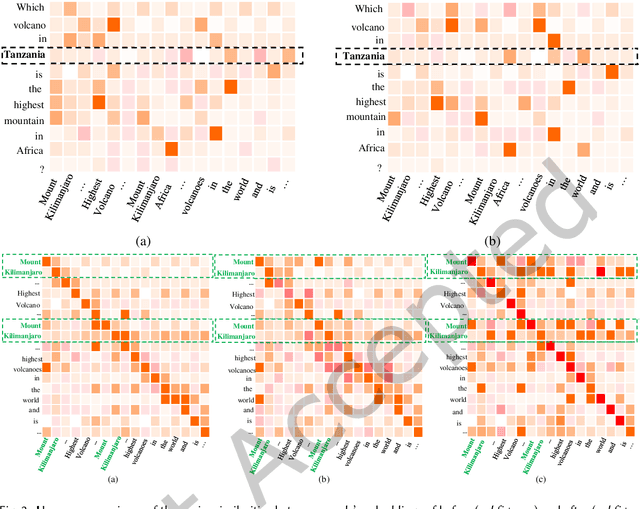
Abstract:Most existing multi-document machine reading comprehension models mainly focus on understanding the interactions between the input question and documents, but ignore following two kinds of understandings. First, to understand the semantic meaning of words in the input question and documents from the perspective of each other. Second, to understand the supporting cues for a correct answer from the perspective of intra-document and inter-documents. Ignoring these two kinds of important understandings would make the models oversee some important information that may be helpful for inding correct answers. To overcome this deiciency, we propose a deep understanding based model for multi-document machine reading comprehension. It has three cascaded deep understanding modules which are designed to understand the accurate semantic meaning of words, the interactions between the input question and documents, and the supporting cues for the correct answer. We evaluate our model on two large scale benchmark datasets, namely TriviaQA Web and DuReader. Extensive experiments show that our model achieves state-of-the-art results on both datasets.
A Simple but Effective Bidirectional Framework for Relational Triple Extraction
Jan 05, 2022
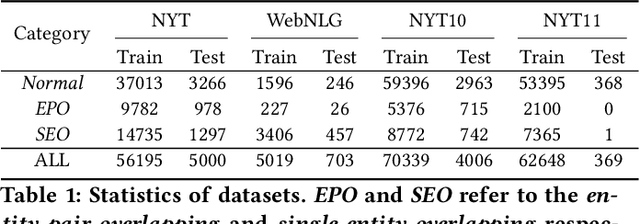
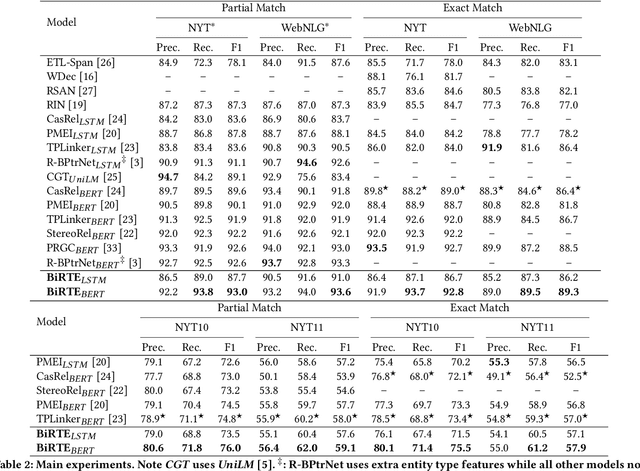

Abstract:Tagging based relational triple extraction methods are attracting growing research attention recently. However, most of these methods take a unidirectional extraction framework that first extracts all subjects and then extracts objects and relations simultaneously based on the subjects extracted. This framework has an obvious deficiency that it is too sensitive to the extraction results of subjects. To overcome this deficiency, we propose a bidirectional extraction framework based method that extracts triples based on the entity pairs extracted from two complementary directions. Concretely, we first extract all possible subject-object pairs from two paralleled directions. These two extraction directions are connected by a shared encoder component, thus the extraction features from one direction can flow to another direction and vice versa. By this way, the extractions of two directions can boost and complement each other. Next, we assign all possible relations for each entity pair by a biaffine model. During training, we observe that the share structure will lead to a convergence rate inconsistency issue which is harmful to performance. So we propose a share-aware learning mechanism to address it. We evaluate the proposed model on multiple benchmark datasets. Extensive experimental results show that the proposed model is very effective and it achieves state-of-the-art results on all of these datasets. Moreover, experiments show that both the proposed bidirectional extraction framework and the share-aware learning mechanism have good adaptability and can be used to improve the performance of other tagging based methods. The source code of our work is available at: https://github.com/neukg/BiRTE.
A Novel Global Feature-Oriented Relational Triple Extraction Model based on Table Filling
Sep 14, 2021Abstract:Table filling based relational triple extraction methods are attracting growing research interests due to their promising performance and their abilities on extracting triples from complex sentences. However, this kind of methods are far from their full potential because most of them only focus on using local features but ignore the global associations of relations and of token pairs, which increases the possibility of overlooking some important information during triple extraction. To overcome this deficiency, we propose a global feature-oriented triple extraction model that makes full use of the mentioned two kinds of global associations. Specifically, we first generate a table feature for each relation. Then two kinds of global associations are mined from the generated table features. Next, the mined global associations are integrated into the table feature of each relation. This "generate-mine-integrate" process is performed multiple times so that the table feature of each relation is refined step by step. Finally, each relation's table is filled based on its refined table feature, and all triples linked to this relation are extracted based on its filled table. We evaluate the proposed model on three benchmark datasets. Experimental results show our model is effective and it achieves state-of-the-art results on all of these datasets. The source code of our work is available at: https://github.com/neukg/GRTE.
A Three-Stage Learning Framework for Low-Resource Knowledge-Grounded Dialogue Generation
Sep 09, 2021

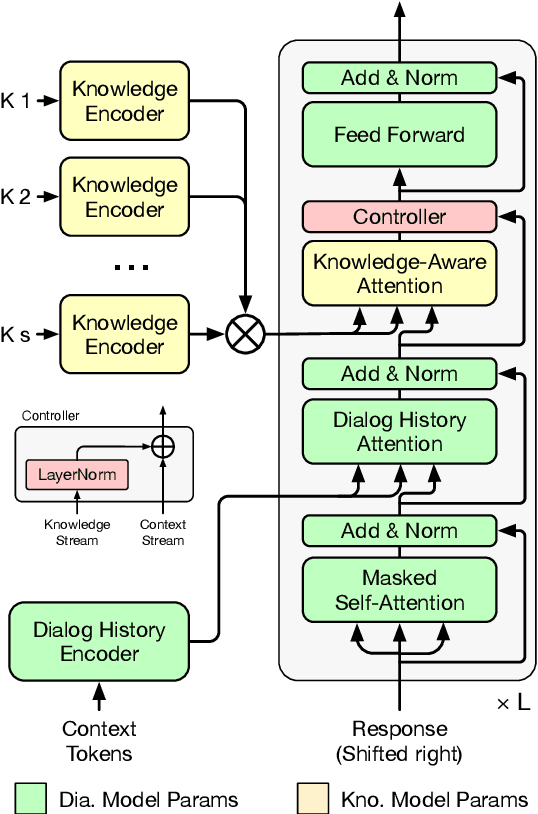

Abstract:Neural conversation models have shown great potentials towards generating fluent and informative responses by introducing external background knowledge. Nevertheless, it is laborious to construct such knowledge-grounded dialogues, and existing models usually perform poorly when transfer to new domains with limited training samples. Therefore, building a knowledge-grounded dialogue system under the low-resource setting is a still crucial issue. In this paper, we propose a novel three-stage learning framework based on weakly supervised learning which benefits from large scale ungrounded dialogues and unstructured knowledge base. To better cooperate with this framework, we devise a variant of Transformer with decoupled decoder which facilitates the disentangled learning of response generation and knowledge incorporation. Evaluation results on two benchmarks indicate that our approach can outperform other state-of-the-art methods with less training data, and even in zero-resource scenario, our approach still performs well.
Knowledge-Grounded Dialogue with Reward-Driven Knowledge Selection
Aug 31, 2021



Abstract:Knowledge-grounded dialogue is a task of generating a fluent and informative response based on both conversation context and a collection of external knowledge, in which knowledge selection plays an important role and attracts more and more research interest. However, most existing models either select only one knowledge or use all knowledge for responses generation. The former may lose valuable information in discarded knowledge, while the latter may bring a lot of noise. At the same time, many approaches need to train the knowledge selector with knowledge labels that indicate ground-truth knowledge, but these labels are difficult to obtain and require a large number of manual annotations. Motivated by these issues, we propose Knoformer, a dialogue response generation model based on reinforcement learning, which can automatically select one or more related knowledge from the knowledge pool and does not need knowledge labels during training. Knoformer is evaluated on two knowledge-guided conversation datasets, and achieves state-of-the-art performance.
A Conditional Cascade Model for Relational Triple Extraction
Aug 20, 2021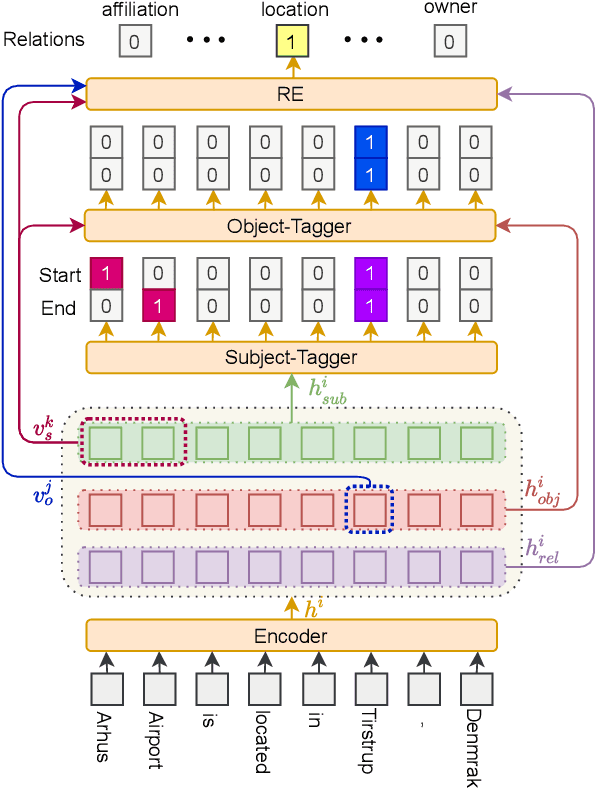
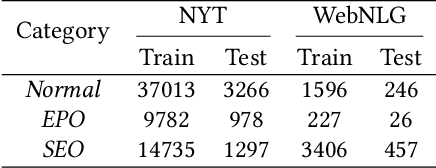
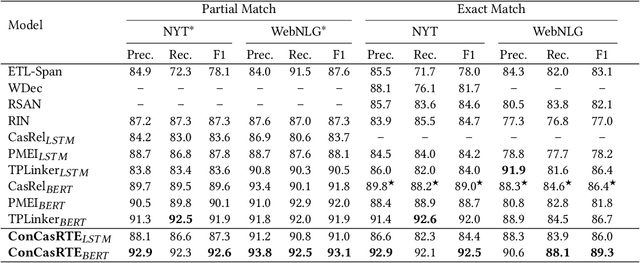

Abstract:Tagging based methods are one of the mainstream methods in relational triple extraction. However, most of them suffer from the class imbalance issue greatly. Here we propose a novel tagging based model that addresses this issue from following two aspects. First, at the model level, we propose a three-step extraction framework that can reduce the total number of samples greatly, which implicitly decreases the severity of the mentioned issue. Second, at the intra-model level, we propose a confidence threshold based cross entropy loss that can directly neglect some samples in the major classes. We evaluate the proposed model on NYT and WebNLG. Extensive experiments show that it can address the mentioned issue effectively and achieves state-of-the-art results on both datasets. The source code of our model is available at: https://github.com/neukg/ConCasRTE.
Knowledge Graph Embedding with Atrous Convolution and Residual Learning
Oct 30, 2020



Abstract:Knowledge graph embedding is an important task and it will benefit lots of downstream applications. Currently, deep neural networks based methods achieve state-of-the-art performance. However, most of these existing methods are very complex and need much time for training and inference. To address this issue, we propose a simple but effective atrous convolution based knowledge graph embedding method. Compared with existing state-of-the-art methods, our method has following main characteristics. First, it effectively increases feature interactions by using atrous convolutions. Second, to address the original information forgotten issue and vanishing/exploding gradient issue, it uses the residual learning method. Third, it has simpler structure but much higher parameter efficiency. We evaluate our method on six benchmark datasets with different evaluation metrics. Extensive experiments show that our model is very effective. On these diverse datasets, it achieves better results than the compared state-of-the-art methods on most of evaluation metrics. The source codes of our model could be found at https://github.com/neukg/AcrE.
LMVE at SemEval-2020 Task 4: Commonsense Validation and Explanation using Pretraining Language Model
Jul 06, 2020



Abstract:This paper describes our submission to subtask a and b of SemEval-2020 Task 4. For subtask a, we use a ALBERT based model with improved input form to pick out the common sense statement from two statement candidates. For subtask b, we use a multiple choice model enhanced by hint sentence mechanism to select the reason from given options about why a statement is against common sense. Besides, we propose a novel transfer learning strategy between subtasks which help improve the performance. The accuracy scores of our system are 95.6 / 94.9 on official test set and rank 7$^{th}$ / 2$^{nd}$ on Post-Evaluation leaderboard.
 Add to Chrome
Add to Chrome Add to Firefox
Add to Firefox Add to Edge
Add to Edge